
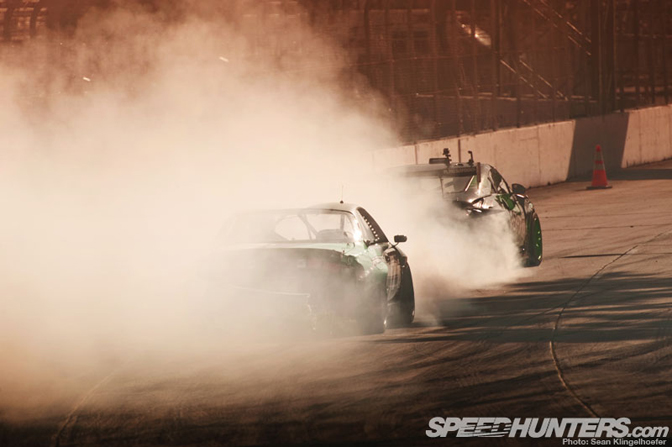
We all know that rules and regulations are a fundamental part of motorsport. Whether in place to simply define the competition or level the playing field, rules play a pivotal role in all motorsports and Formula D is no exception. Competitive drifting is still in its infancy and with each passing year it grows by leaps and bounds. The governing body of Formula D is constantly trying to come up with ways to make the competition fairer and less subjective.
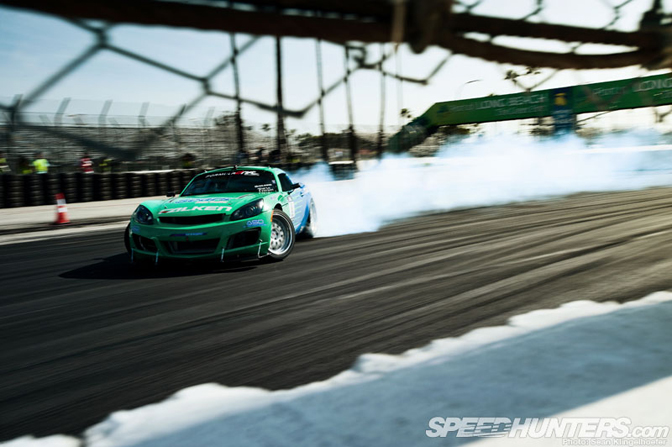
The one rule that most fans seem to be aware of, yet don’t completely understand, is the much discussed “tire rule.” But what exactly is “the tire rule” and how does it effect the competition? Well before we dive into the specifics, let’s first take a look at the round black things on all the cars – the tires. Tires are one part of a car that I presume most of you have some experience with, even if it was only changing a spare.

Whether the ones on your car are of the stretched variety or made of R-Compound sticky stuff, you’ve probably realized that the tire sizing has three basic identifiers – section width, aspect ratio and wheel diameter. The only bit of information that “the tire rule” is concerned with is the first number, the section width. This number i.e. 245, is the width of the tire in millimeters. Since these numbers do fluctuate slightly from manufacturer to manufacturer and model to model, the Formula D techs physically measure the width on each car at every event.
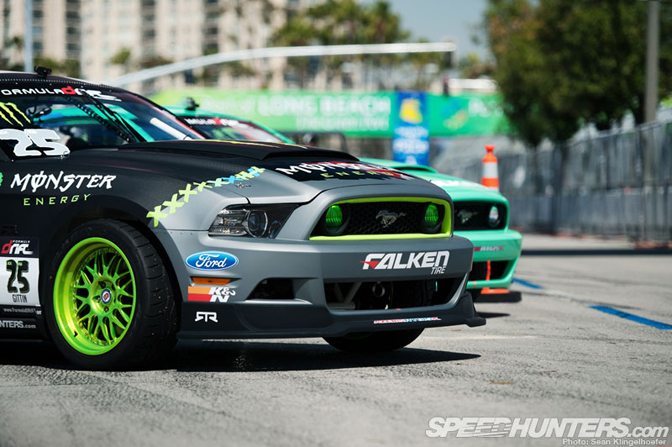
A larger contact patch is good, since as it grows so does the available static grip, and grip is almost everything in motorsport. The more grip you have the harder you can accelerate, the faster you can corner and the deeper you can brake – all of which are good things. Of course there are other factors that affect overall grip, but for now we’ll ignore them since “the tire rule” is only concerned with section width. Now that we’ve got the basics covered, we can look into the rules.
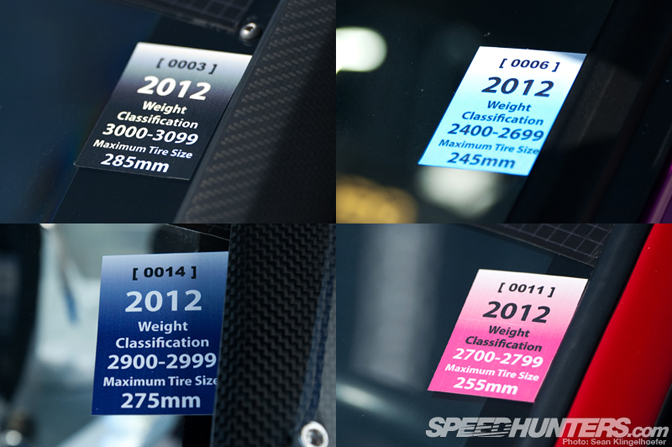
For starters the rule book is only geared towards the size of the rear tires, as these are largely responsible for the performance of a drift car. The cars are weighed in competition trim with the driver in the car and then placed into classes. Once the car has been classified a sticker is placed on the windshield indicating its group.
The classes are as follows:
2100-2399lbs up to 235mm
2400-2699lbs up to 245mm
2700-2799lbs up to 255mm
2800-2899lbs up to 265mm
2900-2999lbs up to 275mm
3000-3099lbs up to 285mm
3100-3199lbs up to 295mm
3200-3299lbs up to 305mm
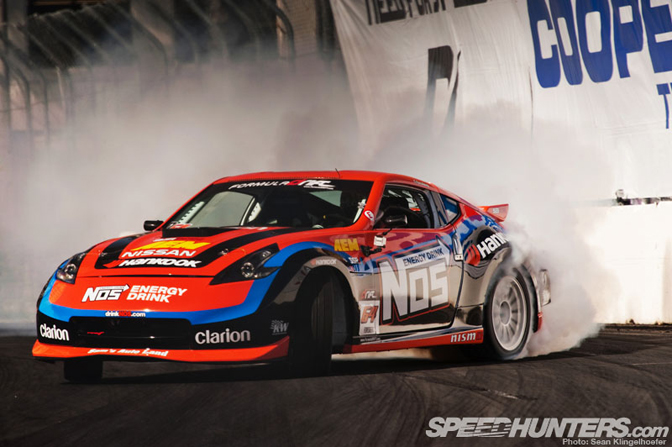
With many regulations in motorsport, the tire rule aims to bring down cost and level the playing field and in this case the contact patch is adjusted in proportion to weight and the teams have options when building a car. This allows heavier muscle cars to compete with lighter JDM chassis without spending buckets of cash lightening the body. Each end of the spectrum has different pros and cons. Some builders will choose a lighter car that won’t have great straight-line speed but will be very toss-able in the corners, whereas a heavier car will be able to pack on the ponies but suffer a little in the twisty bits – everything is a trade off.
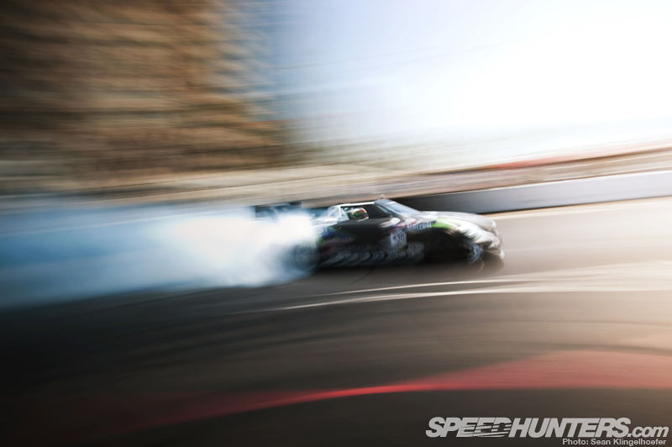
While some may be content at the extreme ends of the spectrums, others will sit closer to the middle. This is the exact setup that the boys at Bridges Racing have decided to run on FD rookie Daigo Saito’s much talked about SC430. After watching the car at Long Beach the setup appears to be solid but not quite as precise as the front-runners. The massive power on board was easily capable of smoking the 275mm Achilles.
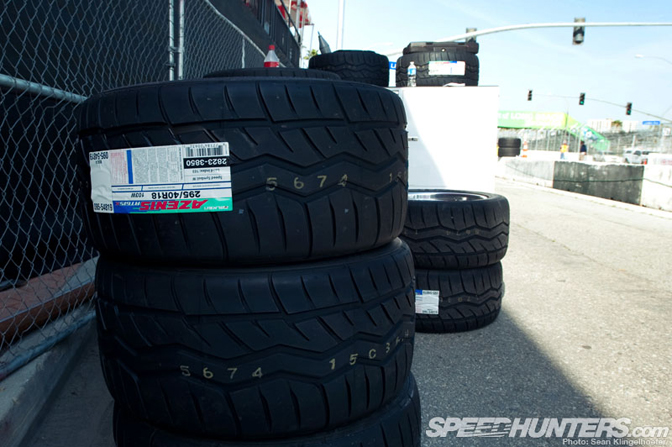
The range of brands and compounds found on the cars throughout the FD paddock makes it a bit difficult to make any concise statements on car setups, particularly after only one event. However it is interesting to take a look at the top two steps of the podium at Long Beach as both drivers were on the same tire but were using two very different tire setups – Dai Yoshihara on 255s with his S13 and Justin Pawlak on 285s with his Mustang. After reviewing their tandem battle a half-dozen times here, I have drawn the following conclusions.

The first thing you’ll notice about Dai’s car is how smoothly it transitions into a drift under its own inertia, it’s almost as if the car wants to drift all on its own. Watching Dai initiate for the first corner looks effortless and it’s obvious the car relies more on suspension setup than brute power to sustain a drift.
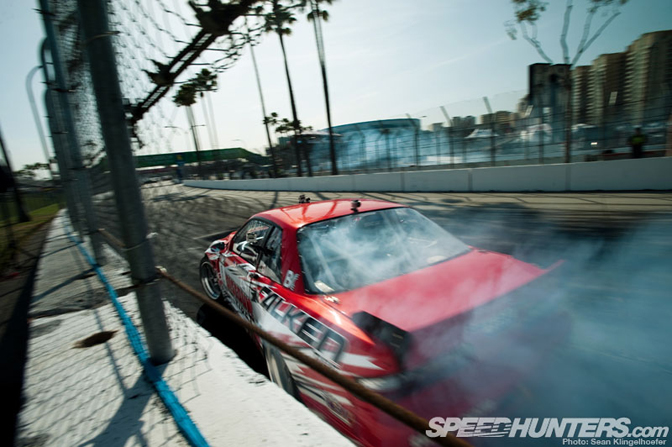
Although arguably a more elegant style, Dai’s angle is noticeably shallower in a few areas of the track in order to maintain big speed, particularly coming out of the final hairpin.
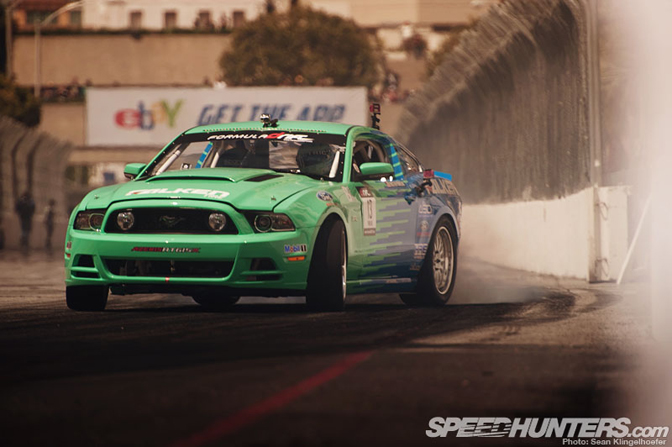
In comparison JTP’s ‘stang is a little more obvious when its weight is thrown about and seems to be a little tougher to initiate off-power. This shortcoming is easily overlooked when the throttle is pinned, it seems to snap into a drift more abruptly and relies heavily on Ford power to keep it going.
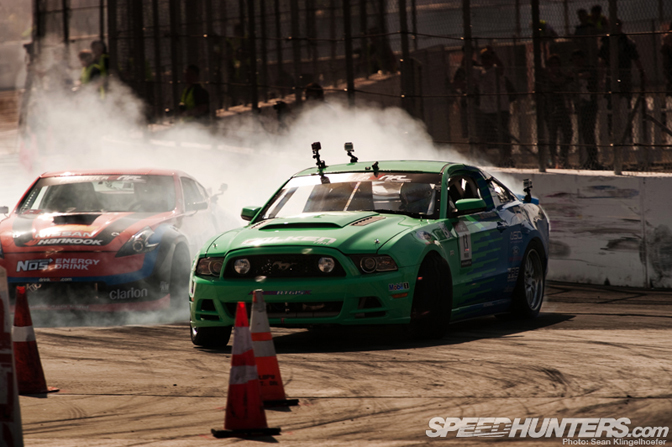
This setup had a decided advantage at Long Beach at the long sweeping section of turn two and the surface change at the hairpin. Some purists could argue, as Rod has mentioned in the past, that Justin’s car spends most of its time power sliding rather than drifting – but that’s a debate for another day.
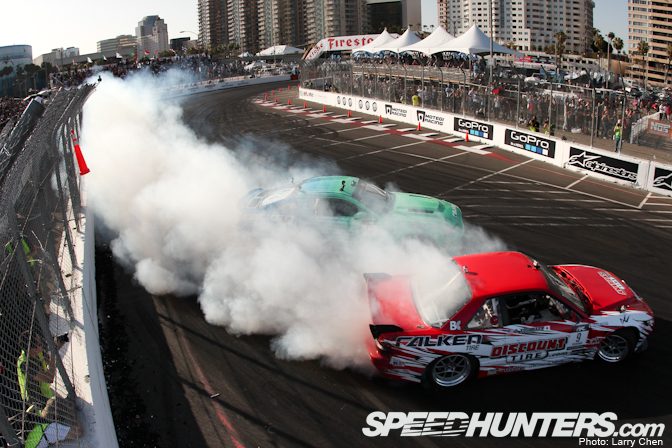
Although there are some key variances to both cars they are decidedly more similar than they are different and my observations are really nit-picks. If you remove subjectivity from the debate the numerical data becomes quite interesting – although he qualified slightly higher than Dai, likely due to slightly more angle mentioned above, JTP’s average speed was 53.9mph to Yoshihara’s 55.6mph. Time will only tell which setup is better as the season progresses, but if nothing else it’s more food for thought while cheering on your favorite drivers. I’d love to hear what you guys think.
Until next time…
More from Formula D Long Beach on Speedhunters
More posts by Sean Klingelhoefer on Speedhunters
-Sean








Awesome article, I would love to keep hearing about regulations, why they are so, and the advantages- like this.
As someone who knows drifting exists but doesn't follow it I have a question that has always confused me.
What *is* the difference between drifting and power sliding? From where I am they seem like the same thing.
Pixel, powersliding is when you boot the throttle in a RWD car, spinning up the tyres and getting the back of the car to step out through a corner. Drifting (I think) is dependent on the handbrake to snap the back around instead. Please, correct me if I'm wrong, don't be nasty etc.
Sean ftw! I'm so glad he shoots for speedhunters now! Yessssssss.
i agree with Hunter M! More tech stuff like this with peoples analysis would be awesome
yeah this article just confused me about power sliding.. i thought Ken Block power slides (AWD) and drifting is (RWD). so i thought is was basically difference in whether the car was AWD or not. Cuz even with all the power that they say JTP has, they forget to mention that Saito is running like 1200 horses in his SC430 and thats a boatload more than the car with the second most hp's..
Keep these coming. The technical stuff definitely needs to be covered more, and dont shy away from going even more technical.
My opinion on powerslide vs. drifting is power sliding is when there is so much power, the rear tires break loose and the car oversteers. Drifiting on the other hand is more a matter of weight transfer and suspension setup which causes the rear to break loose with some help from power. I think the difference boils down to what is primarily causing the rear tires to break loose, whether it's power or steering/braking/weight transfer based
Why on earth is Daigo Saito being referred to as a rookie? Obviously he is new to the states, hence several times this site has referred to him as an 'FD rookie' and I think it was on your Facebook page his third place at Long Beach was called a 'shock result' or something similar.
What the hell? The man has been in D1 since 2004. He's hardly new. America isn't the centre of everything guys...
Can someone explain the difference between drifting and powersliding please?
Interesting article Sean.
Ditto to what Hunter M said. Excellent article Sean!
Dai's car is supposed to be more powerful than last year (taller deck block, longer rods, bigger capacity, more revs) but it seems that the SPD team went for the overall balance of the chassis and drivetrain rather than the brute force the Falken Mustangs seem to represent. It would be interesting to compare Dai's S13 with DMac's Saturn. That thing is a ROCKETSHIP both in the corners and on the straights, but I think it shares the S13s tendency to run slightly shallower but much faster (and IMHO with results slightly more pleasing to the eye than the Falken Mustangs).
Can't wait for the next article!
Thank you for the article great information!
Why on earth is Daigo Saito being referred to as a rookie? Obviously he is new to the states, hence several times this site has referred to him as an 'FD rookie' and I think it was on your Facebook page his third place at Long Beach was called a 'shock result' or something similar.
What the hell? The man has been in D1 since 2004. He's hardly new. America isn't the centre of everything guys...
Powersliding is just getting the rear tires free using power/accelerator. Drifting is a racing method that encompasses many methods of initiation and sustaining the car's speed while sliding.
Look at Powersliding as a moving burnout. Formula Drift = Formula Powersliding. D1GP/SL = Drifting. I love FD but gotta be real here. Our tracks are extended burnouts now.
@ Pixel - though I'm not an expert, I think the main difference is that in a powerslide you initiate the slip of the rear wheels simply by using your right foot for the duration of the corner, while drifting is a fully intentional process of sliding the vehicle through a series of corners (and sometimes on the straights too, manji anyone?) using a plethora of techniques (including braking and intentional destabilizing of the rear end) just to make the car go sideways for show. Simply put, a rally driver might intentionally powerslide a car on slippery surfaces because there isn't much grip available and it's the faster way of going round a corner (just see some videos from Rally Sweden or 1000 Lakes/Finland to see what I mean). On the other hand, a drifter will make use of any technique that's necessary to put the car sideways (always on paved surfaces) and will attempt to keep it that way for as long as possible, and not for the purpose of going faster.
nice article, this is exactly what i want, more in depth technical analysis on drifting ,keep it up
yeah this article just confused me about power sliding.. i thought Ken Block power slides (AWD) and drifting is (RWD). so i thought is was basically difference in whether the car was AWD or not. Cuz even with all the power that they say JTP has, they forget to mention that Saito is running like 1200 horses in his SC430 and thats a boatload more than the car with the second most hp's..
Drifting isn't about using the handbrake, though that can be used. Powersliding is just another way of making a drift happen. Drifting overall is about driving with oversteer but without spinning.
Nice article, but get some one else to talk technical data. Seriously, I would love to see a long boring article on tire size, drifting styles, and various setups. article or link I don't care.
As for "drifting" vs "powersliding", drifting is a sport / stlye of driving, powersliding is a technique of drifing, or being a hoon.
Every driver in formula D "powerslides".
i always thought power sliding is when the car slides after the corner is committed and drifting is when the car starts to slide prior to the corner. but what do I know lol
The topic of powerslide and drifting is a very complicated one of which many debate and have their own views on but to put it simply powerslide is when you apply power (dabbing throttle) to initiate a drift then keep applying power to get around the corner. Drifting is a similar ball game but in drifting your car has traction on the front wheels at an irregular angle due to the initiation of the drift using the handbrake to slip the back wheels round and lose traction on them and apply power (dabbing throttle) to then power you through the corner as you countersteer. With drifting though, there is also alot to do with the momentum, rpm's, clutch and gearing use of the car bneing and there are far more many factors which affact the drift, but these are just the basics. There are also many things that the judges judge on like tyre smoke, fluency etc but do some research online and im'm sure you can learn most things about drifting. Back to the article though, great stuff and love to see more on regulation etc. Loving the work.
+1 what Angus said.
Getting the tail out on a single corner is a powerslide, keeping the tail out alternating directions through a number of corners is drifting.
@Pixel. A powerslide is usually just someone with their boot down and putting the car into a slide through high horsepower. Drifting is more intricate involving a combination of clutch kicks/handbraking to get the car into a drift and for transitioning. That's my thought on it anyway. an example would be seeing a ferrari flooring it around the corner and you see it start to slide (and then they eventually straighten up)
an example would be seeing a ferrari flooring it around the corner and you see it start to slide (and then they eventually straighten up)
Power sliding is relying on your power to slide literally. Power sliding usually only takes place though after the apex of a corner when the rear tires are already struggling for grip. JTP's mustang has so much torque and power he just does a slight turn in the simulate an exit of a apex and can slap the throttle to snap the car into a drift.
Now drifting is just sliding a car through a corner. It's basically how and when the slide is initiated.
1st I think Daigo should have been given the nod for the entire event and podium'd first. And yeah as far as the debate I see in the comments I do think that HookSliding is a huge part of alot of guys games now, but just ith any other sport, if it's not illegal and it works you just gotta accept it and it'll be around for as long as it keeps fooling the judges into thinking its good. IMO the only way to weed out all the HookSliders is to have an actual downhill competition that allows for overtakes and is more cat and mouse than a scored system. GOING BACK TO TIRES THOU ... I think power to the wheels should be considered as well as weight b\c guys like Daigo in his setup will just smokeout and roast anything you throw on them since their power to weight is so insane.
Excellent article, i'd love to see more technical articles like this in the future.
Kg? up to 235mm
Kg? up to 245mm
Kg? up to 255mm
Kg? up to 265mm
Kg? up to 275mm
Kg? up to 285mm
Kg? up to 295mm
Kg? up to 305mm
Give us Kg metric tonnes or something at least!
That is interesting. I've always wondered how many tires does a car go through within and after participating in a drifting race?
Kg? up to 235mm
Kg? up to 245mm
Kg? up to 255mm
Kg? up to 265mm
Kg? up to 275mm
Kg? up to 285mm
Kg? up to 295mm
Kg? up to 305mm
Give us Kg metric tonnes or something at least!
drifting is initiated by some means other than power, whether it be clutch kick, feint, e-brake, or weight transfer. a powerslide is initiated by flooring it, without any other aids.
its hard to powerslide when you have limited power, but you can almost always get some kind of drift going even with limited power.
"A larger contact patch is good, since as it grows so does the available static grip"
Replace "static" with "mechanical." Static means at rest or not in motion. Static doesn't apply to a moving object and would be more apt at describing how well the tire sticks when not actually rotating. Mechanical grip in automotive terms is generally regarded as the amount of grip offered by the tires (and suspension.)
What "IF" the car weighed under 2000lbs.
Great article...keep it up
Drifting includes power sliding in it's descriptions, but to answer your questions the finess of drifting comes from being able to master inertial drifts. Best practice would be with a low-powered short wheelbase car like an old 86 with no peer steering on a downhill type course.
Nice article despite the few terminological mistakes such as the already pointed out static grip thing.
Anyway, what I would love to see in coming technical articles are the unit conversions. Please please please add the metric system units in these articles. The US is not the only place these articles are read.
As stated in most of the comments above, the debate between power sliding and drifting is a heated one. Let me start off by saying, all these comments including my own are just opinions, and should be taken with a grain of salt. Everyone has their own interpretation of what they believe "is right". IMHO there is no difference between drifting and power sliding. With power slides, of course you would need gobs of power to get the tyres initially rotating but once it gets sliding, it in essence does just that. It slides for most of the time with slight taps of the throttle to keep the car sliding and moving foward to prevent the awkward snap of catching grip. With this technique theres really no need for the use of e-brake or clutch clicks...That much. Here's where the debate gets lost in translation. Power sliding is just another technique of drifting. If you have the power, why not use it to your advantage. Again, IMHO drifting is the overall thing that were trying to accomplish. Drifting is sliding within slip the slip angle of the car you're in. At the end of the day, drifitng is drifting. Whether you use gobs of power to initiate and keep your drifting or you use other techniques like feints or clutch kicks it really shouldnt matter. If it makes plumes smoke, you're not spinning and you have massive angle, dont complain. Its all for fun.
KeepDriftingFun
IfItAintARotorItAintAMotor: Although he is great at drifting and is a vet in D1, this is his 1st year at Formula D, which is why he is a rookie in this competition. But just because he is a rookie in FD does not make him bad, its just letting people know this is his 1st time here
I get a kick out of the comments here and on other sites about how Dai's car is primarily competitive based on chassis set-up, while all the Mustangs have is brute power.
HP and Torque is nothing without grip and chassis balance in drifting.
Maybe somebody should just ask the team that builds the cars for one of these "tech" articles? Or ask one of the driver's of the two Mustangs about the focus on chassis set-up vs. horsepower?
Ignorance is bliss I guess. Carry on...
in my opinion powersliding is accidental for example giving it a bit too much power in a turn and kicking the back out whilst racing
effectively power induced oversteer
drifting is the deliberate act of holding the car at the edge of control, trying to achieve maximum angle and speed. part of the reason i dislike formula D is that fact that negative or over 90 degree enties get written off for being "offline" which to me is wrong in a competition like FD it should be skill and car control that determine the winner.
@ Metric ffs. - http://www.convertunits.com/from/lbs/to/kg
@Dan - The reason I said "static" grip is because that's what I was referring to, not mechanical grip. The static friction level and dynamic friction level between a tire and the ground are different. Think of a large box on a smooth floor, it takes much more energy to get the box moving, but once it's sliding it will continue to slide with drastically reduced effort. The same is also true of tires, and since the rear tires spend much of their time spinning, it's important to note the difference between the two states of friction.
@goGreen - A car cannot weigh less than 2100lbs, if they do ballast will be added.
@Olly - I realize that most of you reading this are using the metric system and I'll keep that in mind in the future, the reason I discussed weights in pounds is simply because that's how Formula D lists them.